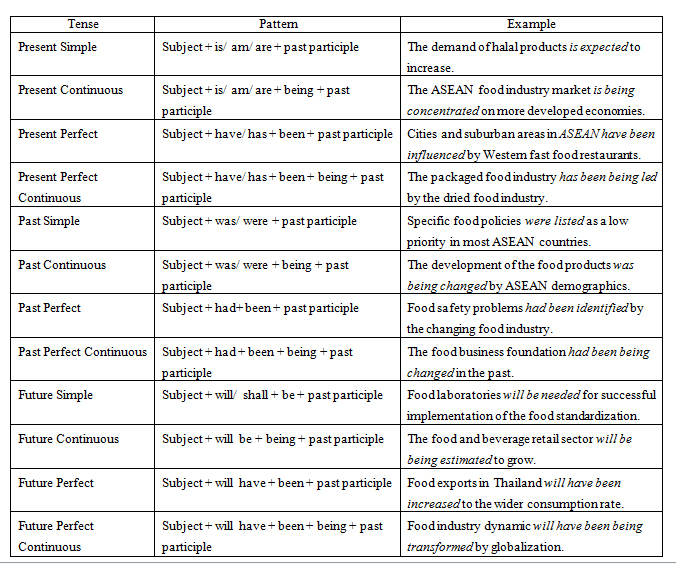Module 15: ASEAN Food Production and Supply
ชุดวิชาภาษาอังกฤษสำหรับงานอาชีพในประชาคมอาเซียน ให้บริการเปิดสอนในภาคการศึกษาที่ 2/2557 จำนวน 15 โมดูลการเรียน
Table of Contents
LanguageFocus
SECTION 15.2
Language Focus 3:
Past and present passive voice
Voice in this context indicates relationship between a subject and a verb and the action expressed by the verb. There are two voices of action: active and passive. Active voice shows that the subject is the doer of the action. Passive voice shows that subject is not the doer of the action.
Some uses for passive voice:
| 1. avoiding mention of the doer The price quotation has now been prepared. |
2. emphasizing the doer (getting information emphasized) |
3. process description (not interested in the agent but in the action) |
4. impersonal language (in formal written language where impersonal tone is intended) |
The present passive is formed with the present tense forms of the verb BE plus past participle. The past passive is formed with the past tense of the verb BE plus past participle:
Present passive voice |
Past passive voice |
is/ am / are + past participle |
was/ were + past participle |
In passive voice, negatives are formed by placing ‘not’ after the verb BE. Contractions are normally used in conversation. Questions are formed by placing the form of the verb BE before the subject.
| Present passive voice | Past passive voice |
Negative |
|
Food color is not described on a label. |
Food color was not described on a label. |
Question |
|
Is food color described on a label? |
Was food color described on a label? |
The person or thing that performs the action is expressed with the prepositional phrase beginning with ‘by’. The phrase comes after the verb.
Present passive voice |
Past passive voice |
Specific food safety policies are required by ASEAN countries. |
Specific food safety policies were required by ASEAN countries. |
The passive is especially found in the impersonal sense.
Present passive voice |
Past passive voice |
Total food exports are expected to touch US$31 billion by the end of 2014. |
Total food exports were expected to touch US$31 billion by the end of 2014. |
Patterns in passive voice
